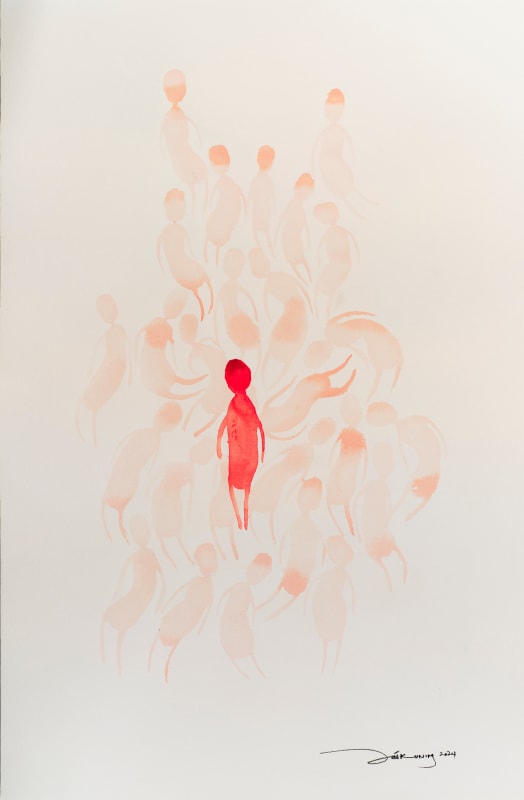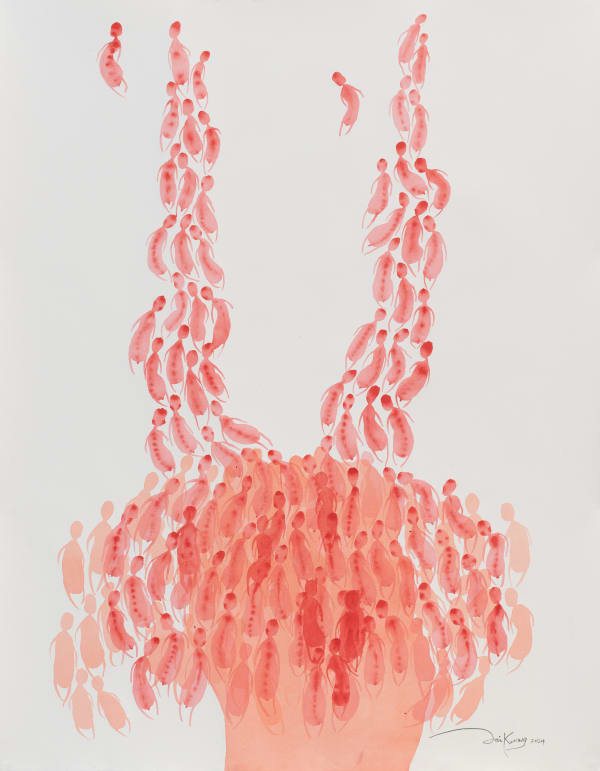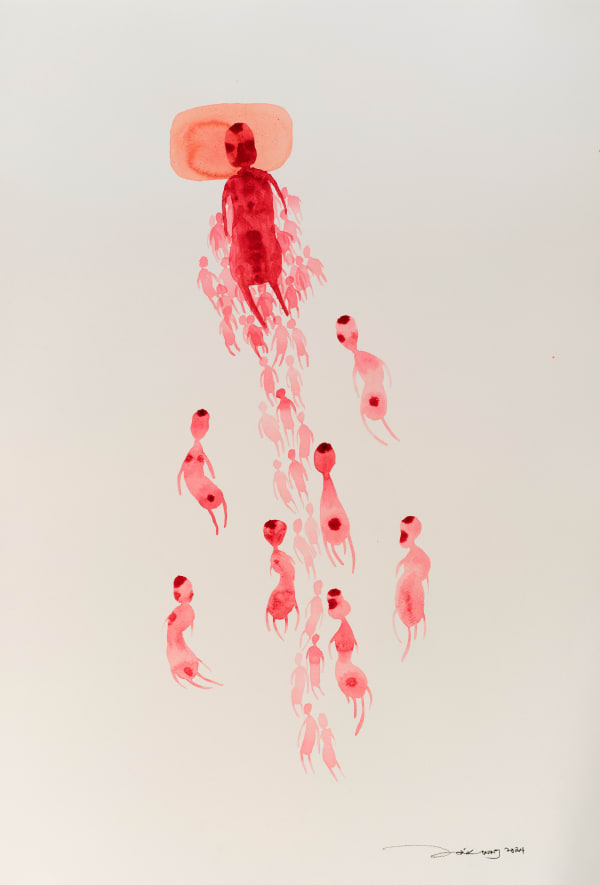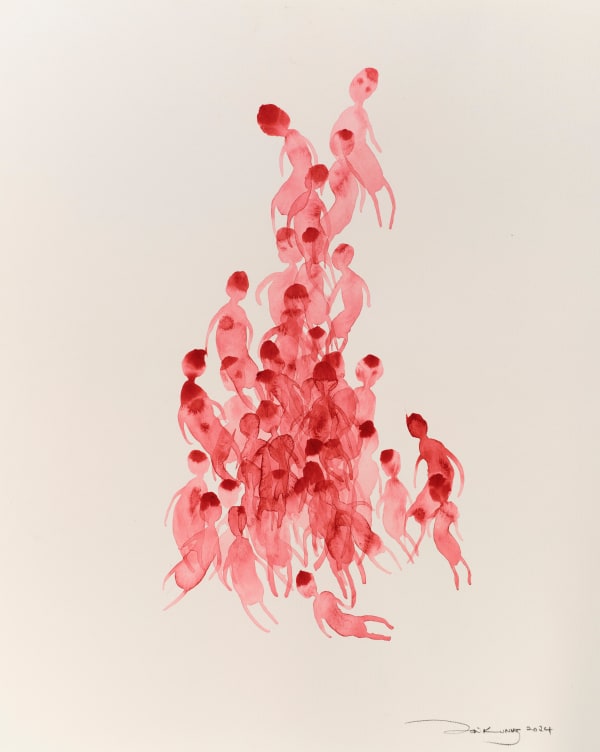I died a hundred times: Zai Kuning
Live painting by the artist
22 June 2024, 17:00 -
Ota Fine Arts Tokyo is delighted to present “I died a hundred times”, Zai Kuning’s first solo exhibition in Japan in 8 years. Having worked with an array of sculpture, installation, painting and drawing, experimental sound and music, video, film, performance art, dance and theatre for more than two decades, Kuning resists convenient categorical claims to his art-making. Multi-disciplinary and improvisational art practice has always been important to him. This exhibition features a new body of works on paper as well as sculptural pieces.
Over the last 3 decades, Zai has been reflecting on many social issues, such as the diminishing cultures of the Orang Laut and Orang Asli, Rohingya refugees, forest-burning practices in parts of Southeast Asia, and the Israel-Hamas war, all of which are inextricably related to life and death. In recent years, he has been thinking more and more about death, following the passing of 3 important figures in his life: his father in 2015, his mother in 2017 and his friend and long-time collaborator Tetsu Saitoh in 2019. In 2023, Zai was diagnosed with Diabetes and started to reflect even more about the reality of death and the time that he is given.
Zai is perhaps most well known for his research and work relating to the Orang Laut -- "sea gypsies" or nomadic indigenous fishermen living in the Riau Archipelago – many of whom have lost their homes due to societal developments beyond their control. He has produced a large body of works narrating the cultures and circumstances of the Orang Laut, culminating in the presentation of a large-scale installation for the Singapore Pavilion at the Venice Biennale in 2017.
Through his interactions with the Orang Laut, Zai learnt that they bury the dead on land, often at a location far away from humans. There is usually no tombstone, and the sites are marked by planting a specific plant near it, often only recognizable by family members. Some of the elderly shared about an old practice of the Orang Laut, which is to build a stilt platform for the deceased respected elderly (similar to their stilt houses) along the river mouth where people do not usually pass through. Sometimes, the platform is in the shape of a boat, or an actual boat is used instead. The stilts prevent it from being washed away by the waves. Eventually, the body will disappear, either consumed by sea creatures or swallowed by the sea itself – nobody knows. This seems to be no longer practiced today and perhaps a myth. Inspired by the Orang Laut’s way of life (and death), Zai created the sculptural pieces in this exhibition. The books represent the knowledge, memories and stories of the elders. As the Orang Laut practice oral history, the history book of their people is in the elders’ minds. The layer of wax on the book is a means of protection and preservation of this knowledge.
While Zai’s past works on paper employed black inks, mineral reds and browns, turmeric yellows and green watercolours, the pieces in this exhibition focus on a single colour of batik dye: Red. The obvious symbolic meaning of the colour alludes to blood, and that regardless of our appearance, thoughts and histories, our blood is ultimately in the same colour, and in the way of nature, we are born and will die eventually. In addition, Zai is also influenced by the red ochre pigment of the Neanderthal cave paintings, and he uses red in this sense to insinuate the simplicity of mark making.
Another significant characteristic of these new works on paper are the layering of human bodies. Each piece is connected to Zai’s observation and meditation about mankind and its own shadow formed by light and its thoughts. “Yesterday seems like a shadow that follows us today, until it becomes the shadow for tomorrow, and all overlaps each other invisibly,” Zai states. “Perhaps life after death is also similar, with one overlapping the other, but we don’t know who is who, including ourselves.” All the drawings are inter-connected in Zai’s thoughts, like a ‘being’ going through his mind, one’s shadows of wish and desire for comfort, protection, companionship or a way home.
-
 Zai KuningRED 8 - All that is passing through our heads, 2024Batik dye on paper115 x 89 cm
Zai KuningRED 8 - All that is passing through our heads, 2024Batik dye on paper115 x 89 cm -
 Zai KuningRED 7 - Not enough pillows for all, 2024Batik dye on paper107.8 x 82.5 cm
Zai KuningRED 7 - Not enough pillows for all, 2024Batik dye on paper107.8 x 82.5 cm -
 Zai KuningRED 4 - For the pillow we know through smell, 2024Batik dye on paper82 x 54.5 cm
Zai KuningRED 4 - For the pillow we know through smell, 2024Batik dye on paper82 x 54.5 cm -
 Zai KuningThe Secrecy of an Invisible Tomb 3, 2024Mixed media (wax, wood, string, book)H38 x 28 x 21 cm
Zai KuningThe Secrecy of an Invisible Tomb 3, 2024Mixed media (wax, wood, string, book)H38 x 28 x 21 cm
Book: H3.5 x 18 x 11.5 cm
Branches: H36 x 28 x 21 cm -
 Zai KuningRED 9 - Escaping the crowd in one's head, 2024Batik dye on paper50.7 x 40.5 cm
Zai KuningRED 9 - Escaping the crowd in one's head, 2024Batik dye on paper50.7 x 40.5 cm -
 Zai KuningRED 4 - For the pillow we know through smell, 2024Batik dye on paper82 x 54.5 cm
Zai KuningRED 4 - For the pillow we know through smell, 2024Batik dye on paper82 x 54.5 cm








